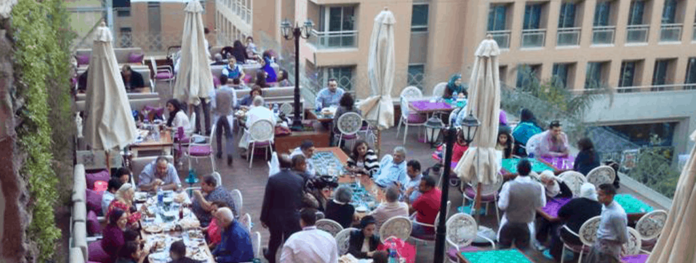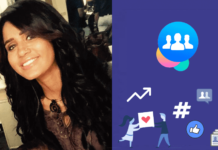
Usually in any brand attack we “the public audience” are clearly aware of the one specific reason that sparked the attack. United Airlines guitar and Domino’s Pizza cases in 2009, Kevin Smith vs Southwest airlines in 2010, and in Egypt #VodaFly the Anti-Vodafone “Abbas Ibn Firnas Ad” campaign also in 2010, or the Left Bank valet case just last year (2014) just to name a few examples – however in this specific case I was confused.
Let’s go through this in detail and try to understand and analyze the case
The first time I noticed the case is when Ahmed Wasel posted this photo on his timeline Saturday 28th complaining about a Minimum charge of 150LE per person being enforced on them by the restaurant and above that over 400LE worth of items were added by the restaurant to sum up to a large invoice.
Ayadina Receipt
The total invoice amount is 1616.39LE
which leads to problem #1
(150LE x 15 = 2250LE not 1616LE), so I started to wonder if there was really any forced minimum charge?
Ahmed Wasel also mentioned that 400LE worth of extra items being added to the invoice, so if we take that into consideration and also remove the 12% service charge and 10% sales tax (which is added by law to every café or restaurant invoice)
1616.39 – 157.44 (service charge) – 146.95 (sales tax) = 1312LE – 400LE = 912LE
and this amount leads to problem #2
It is ordinary in Egypt to pay anywhere from 100 to 200LE per person when dining out at a similar restaurant and 912 / 15 persons = 60LE (and even 1616 / 15 = 107LE) which is low amount to pay and should be considered cheap – You can’t blame a Ferrari for being expensive if you don’t want to pay for it.
Reading down through the comments I notice Heba M. Jackoub trying to re-explain the case stating that the initial invoice was 800LE and the waiter informed them about the 150LE policy and just added 800LE worth of items (so is it 400LE or 800LE!!?) to sum up the amount to 1600LE
and here comes problem #3
If this is actually what happened then this is a pretty straight forward case! Just don’t pay, speak with the manager and/or report to the authorities or Consumer Protection – case closed, why all the fuss and noise? (Although in my personal opinion – how much should a person expect to pay in a Lebanese restaurant in City Stars? 107LE per person is normal if not cheap)
Waiter Offensive Language
Within his post, Ahmed states that the waiter said “كفاية إن المكان إستحملكوا ومحدش ضايقكوا وإنتوا قاعدين” which translates to “Isn’t it enough that the place tolerated you and no one annoyed you” which is something pretty weird to say by a waiter – especially in a Lebanese restaurant, whom are well known for their hospitality – but the surprise is over when I notice this related post by Shady Essam:
Here Shady – who was apparently one of the people dining at the restaurant – posts that the initial invoice was 978LE (not 800LE?) adding a photo of a conversation between himself and Hassan H. Hassan who claims that he was present at the time and they were taking photos, making noise and disturbance leading to 3 other tables leaving the restaurant.
The Resturant Responded Professionally
The response from the restaurant management on Ahmed’s post was professional, giving an apology and asking for their phone numbers to investigate the issue further:
Which apparently did happen as per the post by Ahmed on his page later that day…
Ahmed states that the restaurant owner, a very decent person, gave him a phone call apologizing, the owner was very surprised about what happened, and promised to investigate and take the necessary action against the staff – he also asked Ahmed what would they like as compensation for what happened to them to which Ahmed declined to give an answer pending feedback from the rest of the group.
For God Sake, What is the Problem?
Up to this point everything is pretty normal and I wouldn’t have bothered to write a case study, although details are a bit confusing, yet it is just a simple case of an unsatisfied customer voicing out his concerns and opinion over social media, and the brand responding back in a professional and “client is always right” attitude…
What happened later is that Shady Essam, A Social Media Business Strategist and Social Media Specialist (as per his Facebook profile) decided to take advantage of the situation using his knowledge and skill and directly launch a Brand Attack against the restaurant rather than go through normal channels and use social media as a last resort when all else fails which is the usual action in such cases.
The Brand Attack
What Shady failed to realize (as I will explain later in the article) is that by doing so, he endangers the whole social media industry which is based on organic word of mouth marketing, we have seen the rise of social influencers cultivating thousands of followers (most of which turn out to be fake), just to use their fan base as a platform to advertise products or services (and getting paid to do so) without actual first-hand experience – the public audience don’t want more advertising (or negative PR as in brand attacks), they just want plain facts and it is up to them to make up their own opinions based on those facts, they don’t want more campaigns pushing an opinion or cause based on how many friends a person has, they just want the simple truth.
Brand Reputation?
Shady claims that he monitored the restaurant’s name over social media and found that lots of people having the same complaint…
This claim is backed up by one of Shady’s friends, who also claims that he read all the reviews and found them all “really bad”
Both Shady and BM Ahmed are trying to push the impression of a general bad reputation related to the restaurant, knowing that most of the social media audience fail to authenticate information and take it for granted based on number of fans or knowledge of the person… but with a simple visit to the official restaurant page it is clear what the reputation is, it is mostly 5 stars and I noticed that most of the 1 star reviews were all done within the brand attack campaign by people who had never even visited the restaurant and were just asked by Shady to do reviews…
I remember from memory that the review score was 4.7 right before the attack with only three 1-star reviews
How can the public trust word of mouth opinions if it is not based on first-hand experience? Social media is not your personal vendetta platform, it should be authentic reviews based on experience and targeted towards giving solid feedback rather than generic opinions, how can I (as a public fan) make an opinion and decision to visit the restaurant based on comments such as “bad food”? – define “bad”… is it raw, is it cold, is it too salty, too spicy…etc.? We should empower social media as a solid feedback platform giving it more traction in the market rather than drive away clients who will fear going into social media because of such attacks – clients should see social media as free market research and solid feedback.
One of our clients was reluctant to use social media, and it was only when they saw that they were getting direct raw and solid feedback from their fans and users that it became a healthy win-win partnership between management and fans… fans were becoming the management’s eyes and ears leading to better quality of service – imagine if their first impression was a brand attack!
Educating or Copying From Fans?
Shady views himself as leading by example and helping others to follow in his path – however he is using a wrong example to prove his claim.
The screenshot he used shows a post from March 11th while their case with the restaurant was on the 27th – I don’t see how this is “learning from what he did to the restaurant”… unless they own a time machine! 🙂
Another comment I have is the use of hashtags, if you need to use hashtags, then either build on an already well-established hashtag with solid content that has a chance to gain traction and go viral, or create a “generic” hashtag that has a chance to trend with a large audience… but neither is the case here…
All the Arabic hashtags used are empty, no one else is using them, no one is picking up on them… and even the English hashtag #CaseStudy which is generic and got lots of traffic… the content is neither in English nor is it a CaseStudy… so it will never gain traction with the hashtag audience.
Don’t Block Me!
In his book “The Social Media Manifesto”, Brian Solis states that “Content is the new democracy and we the people, are ensuring that our voices are heard.” and some people are confusing that with having the right to say anything they please over social media without regard to any rules or guidelines.
Here Shady is unhappy with the fact that the restaurant management blocked him along with a few of his friends from the official restaurant page and giving 5 points of advice to the brand:
- If you are a large brand that did a mistake, then apologize to people.
This is the first thing the brand did 4 days earlier, so why the need to give an impression to people that the brand did not apologize? - Respect your clients whoever they are, because they are your true marketers
Having the owner call the client directly to investigate, not a Manager or PR person shows that the brand respects their clients - Deal with social media and understand its power
Doesn’t owning a fan page with over 50K fans and interacting with them proof enough that the brand already deals with social media and understands it’s power? - Don’t Block, Don’t Block, Don’t Block (repeated 9 times)
I can’t agree with Shady here, blocking is there for a reason, Harassing a brand and posting 2nd-hand reviews and using bad language is reason enough to block as per Facebook’s community standards https://www.facebook.com/communitystandards – Apparently Shady needs to read these guidelines as his own account was blocked by Facebook about a month ago – I would have loved to see how he would have pulled off a brand attack against FB on FB J - Before you bully someone into paying money, make sure they are not marketers, make sure they are not marketers… (repeated 10 times)
This cannot be not marketing, legitimate brand attacks should be based on authentic first-hand word of mouth opinion by the public… as a marketer you should know this and provide an authentic case that would go viral on its own… using marketing techniques or paid campaigns defies the “democracy” part in Brian Solis’ quote… and instead of “power to the people” we have “power to the powerful”
There is no such thing as bad publicity
Shady posted this photo claiming that the campaign had negative impact on the restaurants fans…
But any one working in analytics would tell you that taking a snapshot never reveals the true trend, you need to monitor over time to see the whole picture… and fan numbers were never a true indicator of how successful a page is…
The first chart shows the daily interactions since Jan 2015, apparently no impact of any kind… the 2nd chart shows the number of fans, we can clearly see a peak early April (due to the attack) and a sharp decline back to the normal trend (after blocking and removing these fans) – this is the zoomed in area Shady was referring to in his chart claiming the restaurant got affected by his attack.
It seems that it is business as usual for the restaurant, and impact, if any, would be gaining new clients whom are curious to try out and judge for themselves.
The Party Crashers
Red’s, Sceleresque and Alwatania Poultry saw this as an opportunity to increase their engagement and gain a few extra fans… but there’s a huge difference between seizing a trending opportunity and crashing a party to get some free food 🙂
These are a few smart examples of well-recognized brands interacting with a recent trending case… the dress…
However in our case, the 3 crashers seem to have been suffering from low engagement on their own pages and decided to join the party on the restaurants expense…
Sceleresque:
It is clear that their fan numbers got a brief boost during the peak of the attack, however the fan acquisition trend is apparently back to normal – as for the engagement they seem to have been suffering from almost zero engagement and their small stunt seems to have gained them some advantage however this increase in engagement is also declining back to normal.
Red’s:
It is clear that they too got a brief fan boost during the peak of the attack, however the fan acquisition trend is apparently back to normal – as for the engagement they seem be suffering from almost zero engagement… it is also pretty funny whom their key (and only) influencers are:
Alwatania Poultry:
They seem to have a pretty decent fan base and acquisition trend, however in terms of engagement it is low and their stunt seemed to have gained them some interaction, again as in Red’s, Shady seems to have some influence on this engagement increase…
Conclusion
A Brand Attack is not a game to play whenever we feel the need to take revenge… it should be based on pure facts without any personal opinions and having as much links to resources as possible (Wikipedia style) – the only sources we have are a normal receipt, a few unconfirmed stories backed up by an angry mob of friends and some fake reviews.
Ahmed Wasel, the score is 7 out of 10, you should have tried regular channels first before resorting to Social Media, yet you stated the facts as honestly as possible but failed to be clear on the one main item that upsets you, I respect how you posted the restaurant owner’s call transparently and did not give the case larger attention than it needs.
Shady Essam, the score (for both you and your followers) is 1 out of 10, you refused to discuss with the restaurant management when they apologized, and you clearly stated that this is going to be a brand attack (even pledging $200 for it) which makes me wonder about your intention, is it public awareness or fame and revenge?
Ayadina Restaurant, the score is 7 out of 10, reaction should have been stronger and faster, blocking fans should only have been taken as a last option, and results (and actions) of the investigation should have been announced transparently to fans
Red’s, Sceleresque & Alwatania Poultry… nice try but you only get 2 out of 10, this was a cheap under-the-belt shot that only gained you temporary interaction, you need to focus more on creative posts and don’t take advantage of brand attacks, using the right tools you can find far better opportunities to interact with that will positively impact your online brand image.
As for DotMisr and Akhbarak.net… my only comment is that they remind me of the CNN hoax about the death of Morgan Freeman… although in this case it is not a hoax, it is real news posted without verification from all parties… taking posts from the internet and posting as news is a very dangerous game… I would have expected either of them to get a quote from Ayadina management about the case to build a neutral informative news article… I just hope you learn how to play the game correctly in the future and provide news not one-sided opinions.
Tools Used: Hootsuite, Social Bakers & Generic Facebook Insights



